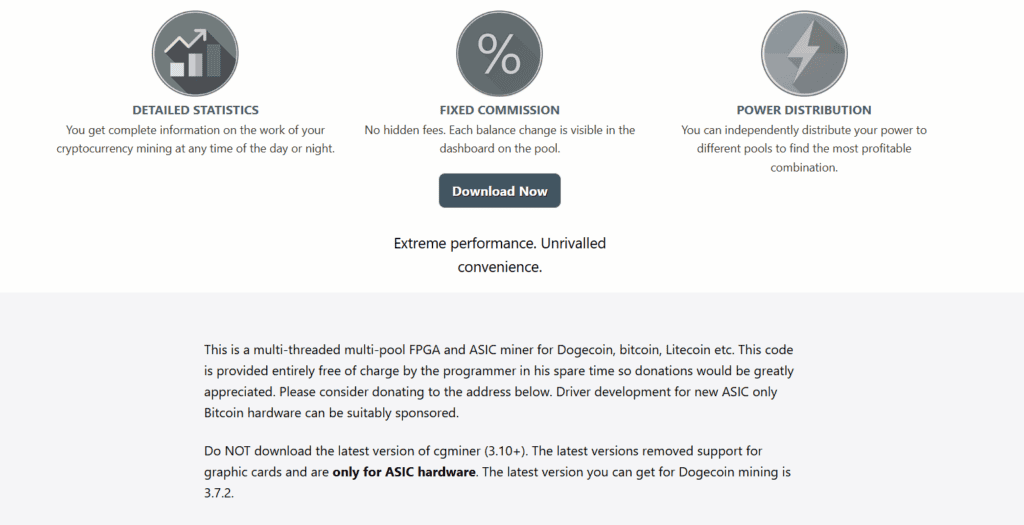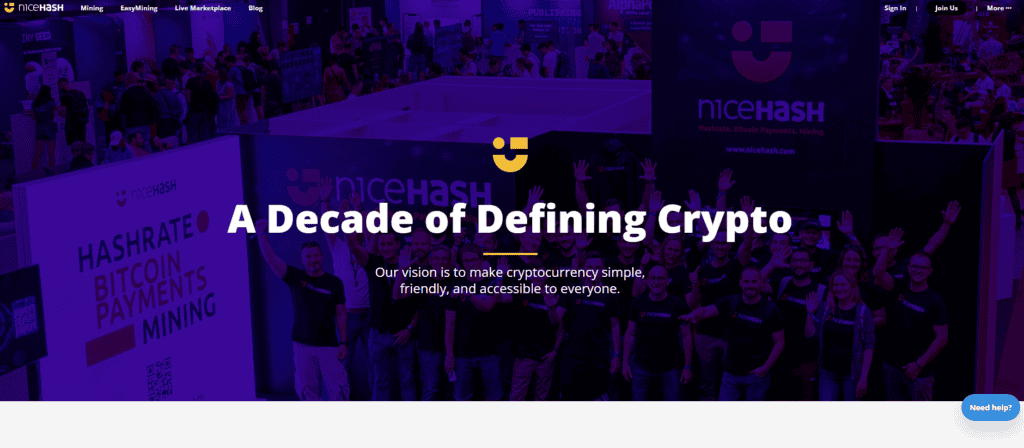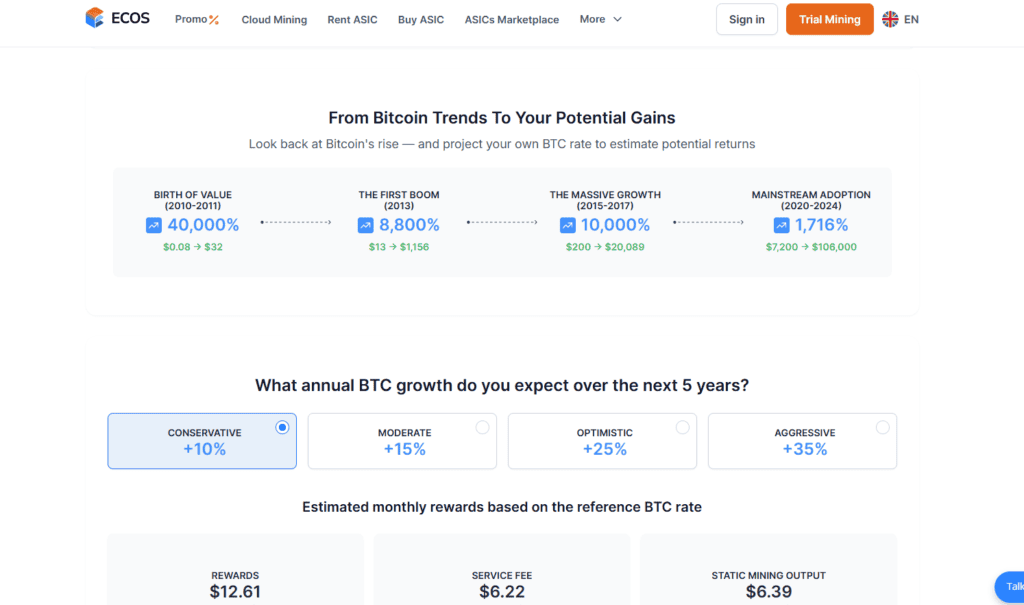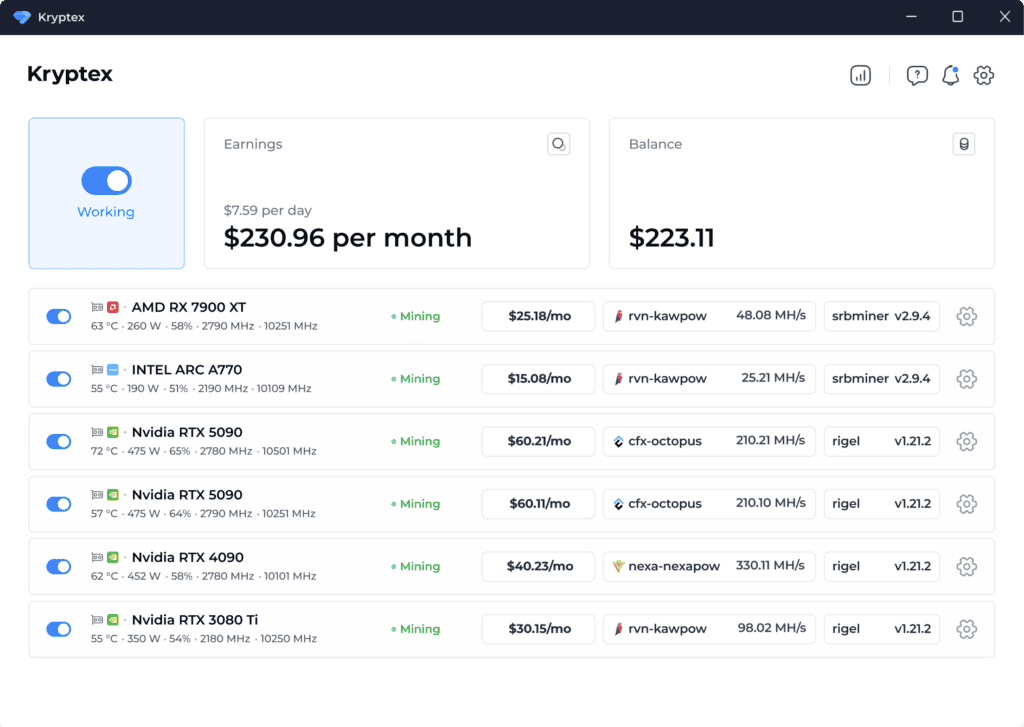Top Bitcoin Mining Software You Should Know: Fees, Power & Ease of Use in 2025

Bitcoin mining has become increasingly competitive, and in 2025, software choice is as important as hardware. The right tool can optimize hashrates, cut energy waste, and simplify payouts, giving miners a real edge.
Different programs serve different needs. Some miners prioritize raw power and transparency, while others value ease of use and quick setup. Factors like fees, compatibility, and scalability help determine the best fit.
In this guide, we review five leading mining platforms: CGMiner, NiceHash, ECOS, Kryptex, and EasyMiner, outlining their strengths, weaknesses, and ideal users.
Top Bitcoin Mining Software
| Mining Software | Supported Operating Systems | Costs |
|---|---|---|
| CGMiner | Windows, Linux, macOS | Free |
| NiceHash | Windows, Linux | 2% service fee |
| ECOS | Cloud-based (Web + Mobile) | From $100 (contract-based) |
| Kryptex | Windows | 1.5–2% fee |
| EasyMiner | Windows, Linux | Free |
1. CGMiner: The Professional’s Open-Source Standard
First released in 2011, CGMiner remains one of the most trusted mining tools. Its open-source code ensures transparency, while advanced controls allow miners to optimize voltage, fan speeds, and performance for maximum efficiency.
CGMiner works with ASICs, GPUs, and FPGAs, and runs on Windows, Linux, and macOS. It’s primarily used for Bitcoin via the SHA-256 algorithm, but forks extend its reach to other coins like Litecoin.
In independent tests with Antminer S19 Pro rigs, CGMiner delivered 6% more stable hashrates than EasyMiner, cementing its reputation as the choice for professionals.
Its downside is complexity: the command-line interface makes it tough for beginners, but seasoned miners appreciate the customization and control.
Pros & Cons
| Pros | Cons |
|---|---|
| Highest ASIC/GPU performance | Steep learning curve |
| Open-source and transparent | CLI may deter newcomers |
| Large, active support community | Antivirus may block installation |
2. NiceHash: Hashpower Marketplace for Beginners
Launched in 2014, NiceHash introduced the world’s largest hashpower marketplace, where users can either mine Bitcoin or sell computing power. Its QuickMiner software makes mining accessible within minutes, especially for newcomers.
NiceHash supports multiple algorithms but pays exclusively in Bitcoin, simplifying profits while letting users try different coins. This feature makes it attractive to miners who want consistent BTC payouts.
According to NiceHash’s 2024 benchmarks, RTX 3070 GPUs generated about $1.9 per day when Bitcoin traded at $42,000. These results highlight its appeal for hobbyists and small-scale miners.
Its main drawback is the 2% service fee, along with reliance on Bitcoin’s market price, which can limit returns for advanced users.
Pros & Cons
| Pros | Cons |
|---|---|
| QuickMiner setup is simple | 2% fee is high |
| BTC payouts for all algorithms | ROI tied to BTC volatility |
| Supports casual and advanced miners | Less control than open-source |
3. ECOS: Regulated Cloud Mining Platform
Operating since 2017 in Armenia’s Free Economic Zone, ECOS has built a reputation as a regulated, eco-friendly cloud mining provider. It removes hardware burdens by offering contracts starting at just $100, giving anyone a way to mine Bitcoin.
ECOS relies on renewable hydroelectric power, aligning with sustainability goals. Its regulated status adds credibility, which is rare in the cloud mining sector.
For example, in 2024, a $1,200 contract generated around 1.05% daily rewards when Bitcoin traded above $40,000. Returns vary with market conditions, but transparency makes ECOS attractive for cautious investors.
The limitation is inflexibility. Contracts lock in funds, so users cannot easily adapt strategies if Bitcoin prices fall.
Pros & Cons
| Pros | Cons |
|---|---|
| No hardware required | Contracts reduce flexibility |
| Regulated & eco-friendly | ROI depends on BTC price |
| Entry plans start at $100 | Not suited for active traders |
4. Kryptex: Mining Made Simple
Kryptex is a straightforward option, ideal for casual miners who want to start without technical hurdles. It supports CPU and GPU mining on standard PCs, making it one of the most accessible platforms.
Beyond Bitcoin, it supports Ethereum Classic and Ravencoin. Kryptex also provides flexible payout options, including crypto wallets, PayPal, and bank transfers, an edge over many rivals.
In 2025, performance tests with RTX 3070 GPUs showed Kryptex earning $1.5–$2 daily, slightly lower than CGMiner but with easier management and faster cashouts. Trustpilot reviews (12,000+) average 4.3/5, reflecting user trust.
Its downside is a 1.5–2% service fee, which makes it less efficient for professionals running large-scale farms.
Pros & Cons
| Pros | Cons |
|---|---|
| Extremely beginner-friendly | Higher fees than open-source |
| Multiple payout methods | Less effective for pro farms |
| Runs quietly in background | Lower hashrates vs CGMiner |
5. EasyMiner: GUI-Friendly Open-Source
EasyMiner offers a graphical interface (GUI), making open-source mining accessible to less technical users. This balance of usability and transparency appeals to hobbyists and small-scale miners.
It supports both SHA-256 and Scrypt algorithms, allowing users to mine Bitcoin, Litecoin, and Dogecoin. EasyMiner works on Windows and Linux, providing flexibility across platforms.
Benchmarks in 2024 showed EasyMiner consuming 20% less RAM than similar tools, though its hashrates were about 3–4% below CGMiner. Despite this, it remains a popular choice for those seeking simplicity with open-source reliability.
Occasional bugs during updates and slightly lower performance compared to CGMiner are its main limitations.
Pros & Cons
| Pros | Cons |
|---|---|
| Easy-to-use GUI | Slightly weaker hashrates |
| Open-source & transparent | Update bugs occur |
| Supports Bitcoin, Litecoin, Dogecoin | Not ideal for pro farms |
Supplementary Insights
When comparing Bitcoin mining software, the key trade-off lies between control and convenience. Free, open-source programs like CGMiner and EasyMiner give users maximum oversight but require technical knowledge. Fee-based platforms like NiceHash and Kryptex emphasize simplicity, while cloud services like ECOS remove hardware barriers altogether.
The right choice depends on your profile as a miner. Professionals and long-term investors typically choose CGMiner or ECOS, while beginners and hobbyists prefer Kryptex or NiceHash. EasyMiner serves those looking for a balance of accessibility and transparency.
Conclusion
The best Bitcoin mining software in 2025 is shaped by your goals, hardware, and skill level. CGMiner leads for advanced miners seeking maximum control, NiceHash and Kryptex simplify entry for beginners, and ECOS and EasyMiner serve as balanced alternatives.
By matching the right tool with your technical confidence and investment appetite, you can improve both profitability and mining efficiency in today’s demanding market.
Frequently Asked Questions
1. What is the best free Bitcoin miner?
The best free option is CGMiner, thanks to its open-source code, no service fees, and unmatched control over ASIC and GPU rigs.
2. Which software is best for GPU mining?
For GPU miners, Kryptex and NiceHash are strong choices. Kryptex is ideal for beginners due to its simple setup, while NiceHash offers flexibility and multiple algorithms.
3. What is the most profitable Bitcoin mining machine?
In 2025, the Antminer S19 Pro remains among the most profitable ASICs, especially when paired with advanced software like CGMiner for maximum efficiency.
4. Is cloud mining still worth it in 2025?
Yes, but cautiously. Platforms like ECOS remove the need for hardware, though profitability heavily depends on Bitcoin’s market price and contract terms.






